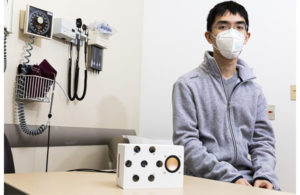
Lead author Anran Wang sits with the smart speaker prototype (white box in foreground) the team used for the study. (Image by Mark Stone, University of Washington)
Hey Alexa, how’s my heart rate?
University of Washington researchers say they’ve devised a way to enable smart speakers to work as contact-free heart-rate monitors.
Their proof-of-concept uses algorithms that transform the smart speaker into a short-range active sonar system and measure heart rate and inter-beat intervals (R-R intervals) for both regular and irregular rhythms, according to a study published in Nature Communications Biology.
Google Nest can determine a user’s distance on its smart speaker by emitting soft, inaudible acoustic signals and analyzing their reflections from the human body. The researchers noted Amazon’s Home Pod and Echo speakers can each support six or seven microphones for acoustic processing.
They tested a smart speaker running their prototype system on two groups: 26 healthy participants and 24 hospitalized patients with atrial fibrillation, flutter and congestive heart failure. Of the nearly 12,300 heartbeats measured for the healthy participants, the smart speaker’s median inter-beat interval was within 28 milliseconds of a standard heart monitor. The smart speaker performed almost as well with cardiac patients: of the more than 5,600 heartbeats measured, the median inter-beat interval was within 30 milliseconds of the standard.
“The motion from someone’s breathing is orders of magnitude larger on the chest wall than the motion from heartbeats, so that poses a pretty big challenge,” said lead author and doctoral student Anran Wang in a news release. “And the breathing signal is not regular so it’s hard to simply filter it out. Using the fact that smart speakers have multiple microphones, we designed a new beam-forming algorithm to help the speakers find heartbeats.”
This “self-supervised” machine learning algorithm, which learns on the fly instead of from a training set, combines signals from all of the smart speaker’s multiple microphones to identify the elusive heartbeat signal. Their algorithms can also detect chest wall motion caused by the heartbeat and arterial pulsations on the body’s surface, separating these signals from much larger breathing motions and ambient noise.
“This is similar to how Alexa can always find my voice even if I’m playing a video or if there are multiple people talking in the room,” said co-senior author Shyam Gollakota, a UW associate professor in the Paul G. Allen School of Computer Science & Engineering. “When I say, ‘Hey, Alexa,’ the microphones are working together to find me in the room and listen to what I say next. That’s basically what’s happening here but with the heartbeat.”
Currently, this system is set up for spot checks: If a person is concerned about their heart rhythm, they can sit in front of a smart speaker to get a reading. But the research team hopes that future versions could continuously monitor heartbeats while people are asleep, which could help doctors diagnose conditions such as sleep apnea.
“If you have a device like this, you can monitor a patient on an extended basis and define patterns that are individualized for the patient. For example, we can figure out when arrhythmias are happening for each specific patient and then develop corresponding care plans that are tailored for when the patients actually need them,” Sridhar said. “This is the future of cardiology. And the beauty of using these kinds of devices is that they are already in people’s homes.”




